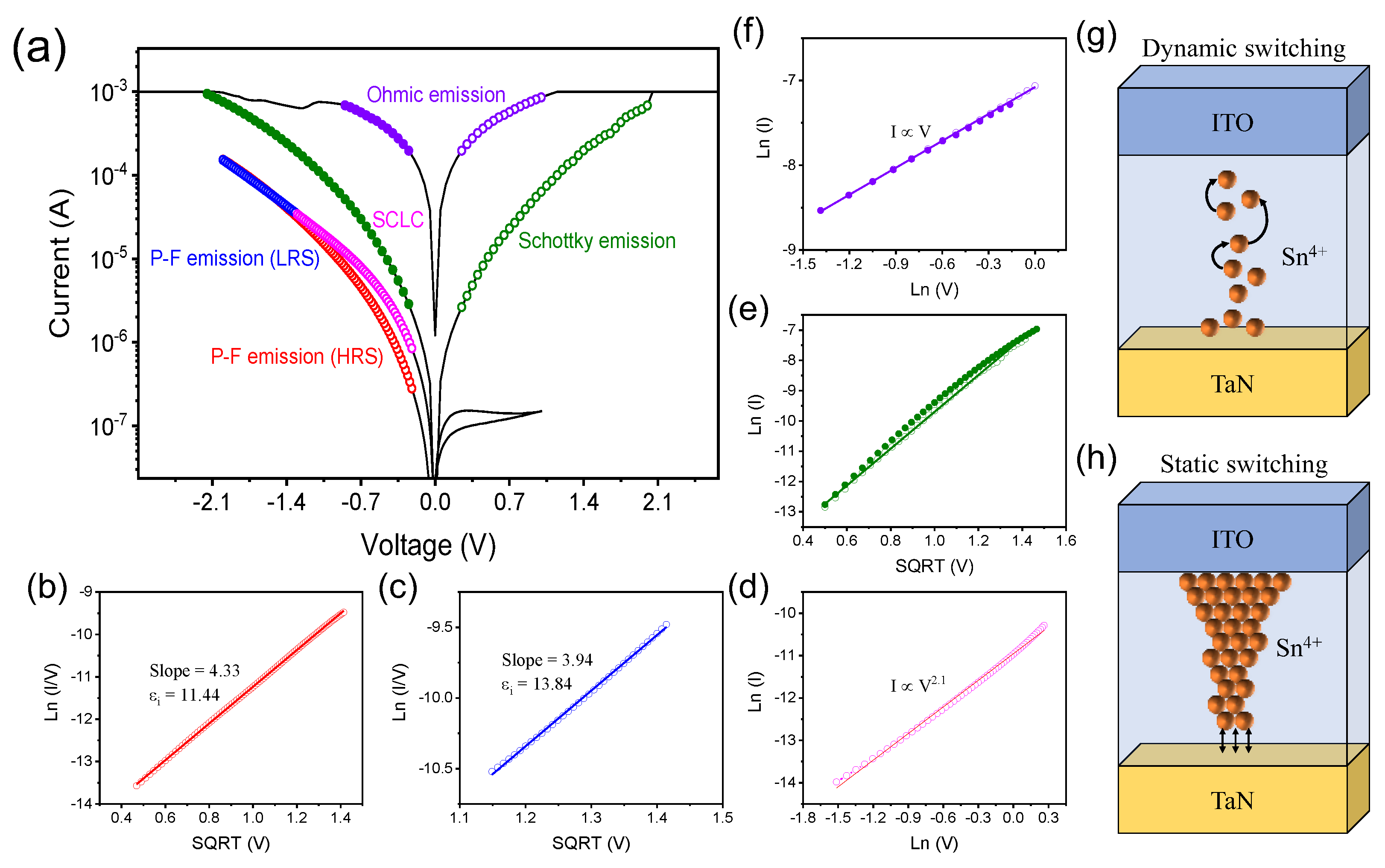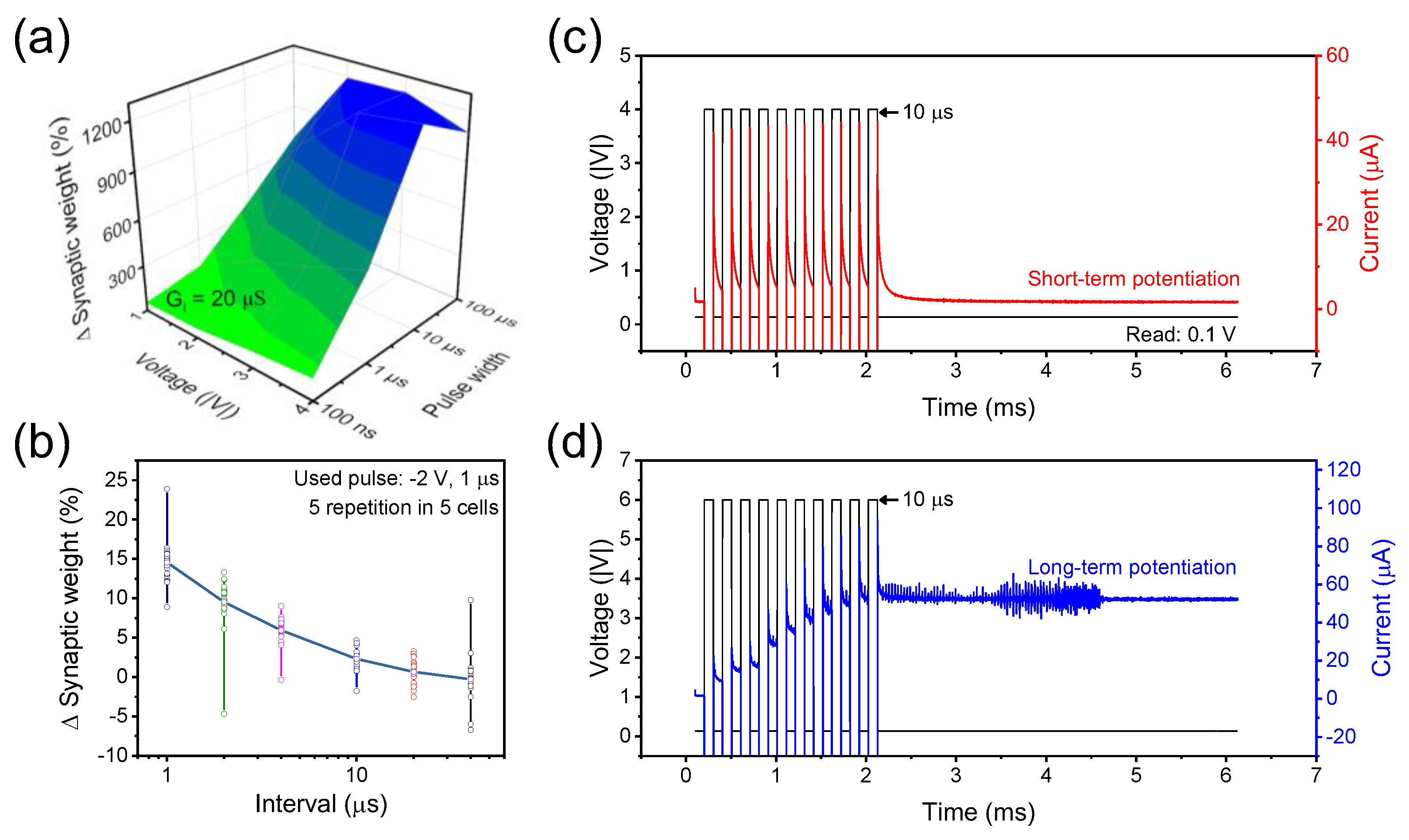Dynamic and Static Switching in ITO/SnOx/ITO and Its Synaptic Application
Abstract
:1. Introduction
2. Results and Discussions
3. Materials and Methods
4. Conclusions
Author Contributions
Funding
Data Availability Statement
Conflicts of Interest
References
- Kang, U.; Chung, H.J.; Heo, S.; Park, D.H.; Lee, H.; Kim, J.H.; Ahn, S.H.; Cha, S.H.; Ahn, J.; Kwon, D.; et al. 8Gb 3D DDR3 DRAM using through-silicon-via technology. IEEE J. Solid State Circuits 2009, 45, 130–131. [Google Scholar] [CrossRef]
- Lee, D.U.; Kim, K.W.; Kim, H.; Kim, J.Y.; Park, Y.J.; Kim, J.H.; Kim, D.S.; Park, H.B.; Shin, J.W.; Cho, J.H.; et al. A 1.2V 8Gb 8-Channel 128GB/s High-Bandwidth Memory (HBM) Stacked DRAM with Effective Microbump I/O Test Methods Using 29nm Process and TSV. In Proceedings of the IEEE International Solid-State Circuits Conference (ISSCC), San Fransisco, CA, USA, 9–13 February 2014; pp. 432–433. [Google Scholar] [CrossRef]
- Fukuzumi, Y.; Katsumata, R.; Kito, M.; Kido, M.; Sato, M.; Tanaka, H.; Nagata, Y.; Matsuoka, Y.; Iwata, Y.; Aochi, H.; et al. Optimal Integration and Characteristics of Vertical Array Devices for Ultra-High Density, Bit-Cost Scalable Flash Memory. In Proceedings of the 2007 IEEE International Conference on Electron Devices Meeting (IEDM), Washington, DC, USA, 10–12 December 2007; pp. 449–452. [Google Scholar] [CrossRef]
- Tanaka, H.; Kido, M.; Yahashi, K.; Oomura, M.; Katsumata, R.; Kito, M.; Fukuzumi, Y.; Sato, M.; Nagata, Y.; Matsuoka, Y.; et al. Bit Cost Scalable technology with Punch and plug process for ultra high density flash memory. In Proceedings of the 2007 IEEE Symposium on VLSI Technology, Kyoto, Japan, 12–14 June 2007; pp. 14–15. [Google Scholar] [CrossRef]
- Kim, J.; Hong, A.J.; Kim, S.M.; Song, E.B.; Park, J.H.; Han, J.; Choi, S.; Jang, D.; Moon, J.-T.; Wang, K.L. Novel Vertical-Stacked Array-Transistor (VSAT) for ultra-high-density and cost-effective NAND flash memory devices and SSD (Solid State Drive). In Proceedings of the 2009 Symposium on VLSI Technology, Kyoto, Japan, 15–17 June 2009; pp. 186–187. [Google Scholar]
- Lee, H.Y.; Chen, P.S.; Wu, T.Y.; Chen, Y.S.; Wang, C.C.; Tzeng, P.J.; Lin, C.H.; Chen, F.; Lien, C.H.; Tsai, M.-J. Low power and high speed bipolar switching with a thin reactive Ti buffer layer in robust HfO2—based RRAM. In Proceedings of the 2008 IEEE International Electron Devices Meeting, San Francisco, CA, USA, 15–17 December 2008; pp. 297–300. [Google Scholar] [CrossRef]
- Milo, V.; Zambelli, C.; Olivo, P.; Pérez, E.; Mahadevaiah, M.K.; Ossorio, O.G.; Wenger, C.; Ielmini, D. Multilevel HfO2-based RRAM devices for low-power neuromorphic networks. APL Mater. 2019, 7, 081120. [Google Scholar] [CrossRef]
- Wong, H.-S.P.; Lee, H.-Y.; Yu, S.; Chen, Y.-S.; Wu, Y.; Chen, P.-S.; Lee, B.; Chen, F.T.; Tsai, M.-J. Metal oxide RRAM. Proc. IEEE 2012, 100, 1951–1970. [Google Scholar] [CrossRef]
- Chen, H.Y.; Brivio, S.; Chang, C.C.; Frascaroli, J.; Hou, T.H.; Hudec, B.; Liu, M.; Lv, H.; Molas, G.; Sohn, J.; et al. Resistive random-access memory (RRAM) technology: From material, device, selector, 3D integration to bottom-up fabrication. J. Electroceram. 2017, 39, 21–38. [Google Scholar] [CrossRef]
- Hong, X.; Loy, D.J.; Dananjaya, P.A.; Tan, F.; Ng, C.; Lew, W. Oxide-based RRAM materials for neuromorphic computing. J. Mater. Sci. 2018, 53, 8720–8746. [Google Scholar] [CrossRef]
- Madelung, O. Semiconductors: Data Handbook, 3rd ed.; Springer: Berlin/Heidelberg, Germany, 2004. [Google Scholar]
- Klein, A.; Körber, C.; Wachau, A.; Säuberlich, F.; Gassenbauer, Y.; Harvey, S.P.; Proffit, D.E.; Mason, T.O. Transparent Conducting Oxides for Photovoltaics: Manipulation of Fermi Level, Work Function and Energy Band Alignment. Materials 2010, 3, 4892–4914. [Google Scholar] [CrossRef] [PubMed] [Green Version]
- Chen, D.; Huang, S.H. Investigation of resistive switching behavior of Ag/SnOX/ITO device. J. Micro/Nanolithogr. MEMS MOEMS 2015, 14, 024501. [Google Scholar] [CrossRef]
- Pyo, J.; Woo, S.; Lee, K.; Kim, S. Demonstration of Threshold Switching and Bipolar Resistive Switching in Ag/SnOX/TiN Memory Device. Metals 2021, 11, 1605. [Google Scholar] [CrossRef]
- Jin, J.; Zhang, J.; Kemal, R.E.; Luo, Y.; Bao, P.; Althobaiti, M.; Hesp, D.; Dhanak, V.R.; Zheng, Z.; Mitrovic, I.Z.; et al. Effects of annealing conditions on resistive switching characteristics of SnOX thin films. J. Alloy. Compd. 2016, 673, 54–59. [Google Scholar] [CrossRef]
- Hu, R.; Li, X.; Tang, J.; Li, Y.; Zheng, X.; Gao, B.; Qian, H.; Wu, H. Investigation of Resistive Switching Mechanisms in Ti/TiOX/Pd-Based RRAM Devices. Adv. Electron. Mater. 2021, 12, 2100827. [Google Scholar] [CrossRef]
- Zhong, Y.; Tang, J.; Li, X.; Gao, B.; Qian, H.; Wu, H. Dynamic memristor-based reservoir computing for high-efficiency temporal signal processing. Nat. Commun. 2021, 12, 408. [Google Scholar] [CrossRef]
- Ohno, T.; Hasegawa, T.; Tsuruoka, T.; Terabe, K.; Gimzewski, J.K.; Aono, M. Short-term plasticity and long-term potentiation mimicked in single inorganic synapses. Nat. Mater. 2011, 10, 591–595. [Google Scholar] [CrossRef]
- Shin, J.; Kang, M.; Kim, S. Gradual conductance modulation of Ti/WOX/Pt memristor with self-rectification for a neuromorphic system. Appl. Phys. Lett. 2021, 119, 012102. [Google Scholar] [CrossRef]
- Kim, D.; Lee, J.S. Designing artificial sodium ion reservoirs to emulate biological synapses. NPG Asia Mater. 2020, 12, 62. [Google Scholar] [CrossRef]
- Ismail, M.; Mahata, C.; Kim, S. Electronic synaptic plasticity and analog switching characteristics in Pt/TiOX/AlOX/AlTaON/TaN multilayer RRAM for artificial synapses. Appl. Surf. Sci. 2022, 599, 153906. [Google Scholar] [CrossRef]
- Sun, Y.; He, N.; Wen, D.; Sun, F. The nonvolatile resistive switching memristor with Co-Ni layered double hydroxide hybrid nanosheets and its application as a artificial synapse. Appl. Surf. Sci. 2021, 564, 150452. [Google Scholar] [CrossRef]
- Yan, X.; Zhao, Q.; Chen, A.P.; Zhao, J.; Zhou, Z.; Wang, J.; Wang, H.; Zhang, L.; Li, X.; Xiao, Z.; et al. Vacancy-Induced Synaptic Behavior in 2D WS2 Nanosheet–Based Memristor for Low-Power Neuromorphic Computing. Small 2019, 15, 1901423. [Google Scholar] [CrossRef]
- Ryu, J.-H.; Kim, B.; Hussain, F.; Mahata, C.; Ismail, M.; Kim, Y.; Kim, S. Bio-inspired synaptic functions from a transparent zinc-tin-oxide-based memristor for neuromorphic engineering. Appl. Surf. Sci. 2021, 544, 148796. [Google Scholar] [CrossRef]
- Hsu, C.C.; Chuang, P.Y.; Chen, Y.T. Resistive switching characteristic of low-temperature top-electrode-free tin-oxide memristor. IEEE Trans. Electron Devices 2017, 64, 3951–3954. [Google Scholar] [CrossRef]
- Rahmani, M.K.; Ismail, M.; Mahata, C.; Kim, S. Effect of interlayer on resistive switching properties of SnO2 -based memristor for synaptic application. Results Phys. 2020, 18, 103325. [Google Scholar] [CrossRef]
- Khan, A.F.; Mehmo Mehmood, M.; Rana, A.M.; Bhatti, M.T. Effect of annealing on electrical resistivity of rf-magnetron sputtered nanostructured SnO2 thin films. Appl. Surf. Sci. 2009, 255, 8562–8565. [Google Scholar] [CrossRef]
- Chiu, F. A review on conduction mechanisms in dielectric films. Adv. Mater. Sci. Eng. 2014, 2014, 578168. [Google Scholar] [CrossRef]
- Gul, F. A simplified method to determine carrier transport mechanisms of metal-oxide resistive random-access memory (RRAM) devices. Mater. Today: Proc. 2021, 46, 6976–6978. [Google Scholar] [CrossRef]
- Chiu, F.C.; Lee, C.Y.; Pan, T.M. Current conduction mechanisms in Pr2O3/oxynitride laminated gate dielectrics. J. Appl. Phys. 2009, 105, 074103. [Google Scholar] [CrossRef]
- Hsu, C.C.; Chuang, P.Y.; Lin, Y.S. Volatile memory characteristics of a solution-processed tin oxide semiconductor. IEEE Electron Device Lett. 2019, 40, 395–398. [Google Scholar] [CrossRef]
- Yazdanparast, S.; Koza, J.A.; Switzer, J.A. Copper nanofilament formation during unipolar resistance switching of electrodeposited cuprous oxide. Chem. Mater. 2015, 27, 5974–5981. [Google Scholar] [CrossRef]
- Barr, T.J.; Sampaio, R.N.; DiMarco, B.N.; James, E.M.; Meyer, G.J. Phantom electrons in mesoporous nanocrystalline SnO2 thin films with cation-dependent reduction onsets. Chem. Mater. 2017, 29, 3919–3927. [Google Scholar] [CrossRef]
- Kim, S.; Kim, H.; Jung, S.; Kim, M.H.; Lee, S.; Cho, S.; Park, B.G. Tuning resistive switching parameters in Si3N4 -based RRAM for three-dimensional vertical resistive memory applications. J. Alloy. Compd. 2016, 663, 419–423. [Google Scholar] [CrossRef]
- Xing, Y.; Sueoka, B.; Cheong, K.Y.; Zhao, F. Nonvolatile resistive switching memory based on monosaccharide fructose film. Appl. Phys. Lett. 2021, 119, 163302. [Google Scholar] [CrossRef]
- Huang, Y.J.; Lee, S.C. Graphene/h-BN Heterostructures for Vertical Architecture of RRAM Design. Sci. Rep. 2017, 7, 9679. [Google Scholar] [CrossRef]




| Etch Time | Area Ratio O-Sn2+ | O-Sn4+ | Area Ratio Sn2+ | Sn4+ | Ratio of Sn2+/Sn4+ |
|---|---|---|---|---|---|
| 200 s | 46.3% | 44.8% | 53.9% | 32.0% | 1.68 |
| 248 s | 36.0% | 50.2% | 51.9% | 45.6% | 1.14 |
Publisher’s Note: MDPI stays neutral with regard to jurisdictional claims in published maps and institutional affiliations. |
© 2022 by the authors. Licensee MDPI, Basel, Switzerland. This article is an open access article distributed under the terms and conditions of the Creative Commons Attribution (CC BY) license (https://creativecommons.org/licenses/by/4.0/).
Share and Cite
Park, J.; Park, H.; Chung, D.; Kim, S. Dynamic and Static Switching in ITO/SnOx/ITO and Its Synaptic Application. Int. J. Mol. Sci. 2022, 23, 9995. https://doi.org/10.3390/ijms23179995
Park J, Park H, Chung D, Kim S. Dynamic and Static Switching in ITO/SnOx/ITO and Its Synaptic Application. International Journal of Molecular Sciences. 2022; 23(17):9995. https://doi.org/10.3390/ijms23179995
Chicago/Turabian StylePark, Jongmin, Hyunwoong Park, Daewon Chung, and Sungjun Kim. 2022. "Dynamic and Static Switching in ITO/SnOx/ITO and Its Synaptic Application" International Journal of Molecular Sciences 23, no. 17: 9995. https://doi.org/10.3390/ijms23179995
APA StylePark, J., Park, H., Chung, D., & Kim, S. (2022). Dynamic and Static Switching in ITO/SnOx/ITO and Its Synaptic Application. International Journal of Molecular Sciences, 23(17), 9995. https://doi.org/10.3390/ijms23179995







